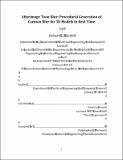| dc.contributor.advisor | Andrew Grant. | en_US |
| dc.contributor.author | Smith, Robert L. M. Eng. Massachusetts Institute of Technology | en_US |
| dc.contributor.other | Massachusetts Institute of Technology. Department of Electrical Engineering and Computer Science. | en_US |
| dc.date.accessioned | 2017-01-12T18:18:18Z | |
| dc.date.available | 2017-01-12T18:18:18Z | |
| dc.date.copyright | 2016 | en_US |
| dc.date.issued | 2016 | en_US |
| dc.identifier.uri | http://hdl.handle.net/1721.1/106376 | |
| dc.description | Thesis: M. Eng., Massachusetts Institute of Technology, Department of Electrical Engineering and Computer Science, 2016. | en_US |
| dc.description | This electronic version was submitted by the student author. The certified thesis is available in the Institute Archives and Special Collections. | en_US |
| dc.description | Cataloged from student-submitted PDF version of thesis. | en_US |
| dc.description | Includes bibliographical references (page 48). | en_US |
| dc.description.abstract | One of the notable distinctions of traditional animation techniques is the emphasis placed on motion. Objects in motion often make use of visual stylistic effects to visually enhance the motion, such as speed lines or afterimages. Unfortunately, at present, 2D animation makes much more use of these techniques than 3D animation, which is especially clear in the stylistic differences between 2D and 3D videogames. For 3D videogame designers fond of the look and feel of traditional animation, it would be beneficial if 3D models could emulate that 2D style. In that regard, I propose two techniques that use the location history of 3D models to, in real time, construct non-photorealistic motion blur effects in the vein of 2D traditional animation. With these procedural techniques, designers can maximize the convenience of 3D models while still retaining an aesthetic normally constrained to 2D animation. | en_US |
| dc.description.statementofresponsibility | by Robert L. Smith. | en_US |
| dc.format.extent | 48 pages | en_US |
| dc.language.iso | eng | en_US |
| dc.publisher | Massachusetts Institute of Technology | en_US |
| dc.rights | M.I.T. theses are protected by copyright. They may be viewed from this source for any purpose, but reproduction or distribution in any format is prohibited without written permission. See provided URL for inquiries about permission. | en_US |
| dc.rights.uri | http://dspace.mit.edu/handle/1721.1/7582 | en_US |
| dc.subject | Electrical Engineering and Computer Science. | en_US |
| dc.title | Afterimage Toon Blur : procedural generation of cartoon blur for 3D models in real time | en_US |
| dc.title.alternative | Procedural generation of cartoon blur for 3D models in real time | en_US |
| dc.type | Thesis | en_US |
| dc.description.degree | M. Eng. | en_US |
| dc.contributor.department | Massachusetts Institute of Technology. Department of Electrical Engineering and Computer Science | |
| dc.identifier.oclc | 967348305 | en_US |
